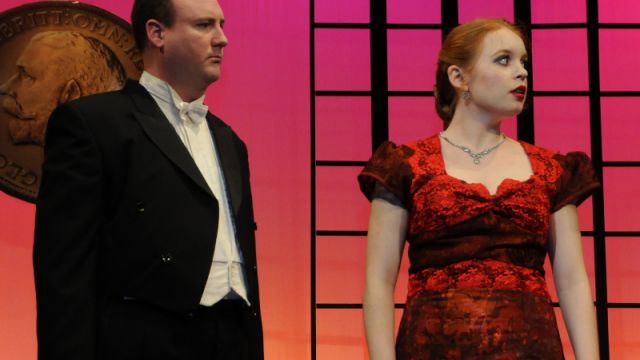Dangerous Corner
This is J. B. Priestly’s first play. Written in the early 1930s, Priestly, a socialist, used the popular murder mystery genre to expose the wanton behaviour he believed existed beneath the veneer of respectability of the British bourgeoisie.
Set after a dinner party at the home of a Freda and Robert Caplan, a wealthy couple involved in a family publishing company, the opening of a cigarette box leads to a series of accusations and admissions – unrequited love (of various kinds!), promiscuity, theft, drug addiction, murder and adultery! Priestly certainly seems to have had it in for the nouveau riche!
The play has all the features of the drama of the time. Written in three acts, it involves long and circuitous expositions and some repetitious dialogue that needs to be pushed along quickly to avoid the static action and ponderous delivery that can occur in contemporary productions of such works.
 Elinor Portch as Freda, and Elizabeth MacGregor, as Olwen Peel (long time employee of the firm and family friend) go some of the way to achieving this, as does John Grinston, as Charles Stanton (another employee and family friend!) as accusations, insults and declarations mount and mount. But the directorial decision to allow the dialogue alone to carry the play means that this production is dogged by lack of pace and action.
Elinor Portch as Freda, and Elizabeth MacGregor, as Olwen Peel (long time employee of the firm and family friend) go some of the way to achieving this, as does John Grinston, as Charles Stanton (another employee and family friend!) as accusations, insults and declarations mount and mount. But the directorial decision to allow the dialogue alone to carry the play means that this production is dogged by lack of pace and action.
There is much standing and listening; many long stares and rolled eyes. There is little variation in tempo or pitch, so much so that when John Willis-Richards (Gordon Whitehouse, Freda’s brother) does react loudly and a little violently, it is jarring, appears out of context, in some cases raises embarrassed laughter from the audience.
Though the set is attractive and costumes appropriate for the time and setting, the action lacks the spark and pace that is needed to make the characters believable enough to achieve Priestly’s real intent.
Carol Wimmer
Subscribe to our E-Newsletter, buy our latest print edition or find a Performing Arts book at Book Nook.

